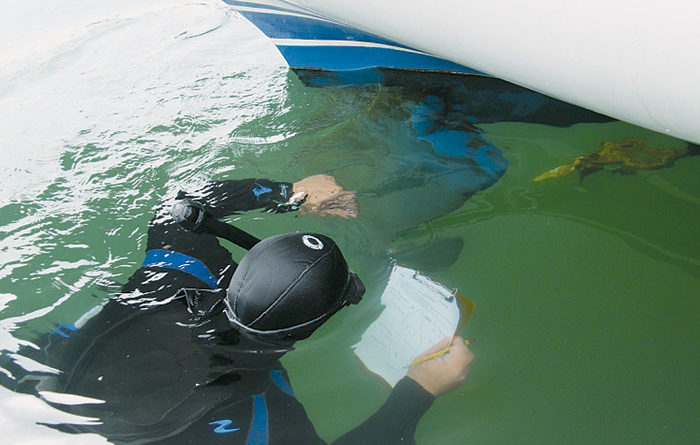Commissioners Approve 8-Week Pause for In-Water Hull Cleaning in Shelter Island Yacht Basin
The pause is a part of a pilot study proposed by Port of San Diego staff as an effort to meet a state-mandated 2022 deadline to reduce copper levels in this area of the bay, which exceeds federal and state water quality standards.
SAN DIEGO— The Port of San Diego plans to mandate a pause on in-water hull cleaning on vessels in the Shelter Island Yacht Basin for an eight-week stretch this winter. The pause is part of a proposed pilot study, which aims to provide understanding of how in-water hull cleaning impacts water quality, specifically copper levels, as the Port faces a 2022 deadline to reduce elevated copper levels in the Shelter Island Yacht Basin.
The proposed in-water hull cleaning pilot study was presented to the San Diego Board of Port Commissioners on June 15 and the board voted to mandate an eight-week pause on in-water hull cleaning for the study to be conducted.
The study will involve four weeks of water quality sampling in the fall of 2021, followed directly by eight weeks of water quality sampling during the mandated no in-water hull cleaning in the winter of 2021/2022, and then another four weeks of water quality sampling after the pause.
A Dissolved Copper Total Maximum Daily Load for the Shelter Island Yacht Basin set by the regional water board in 2005 due to copper levels that exceeded federal and state water quality standards requires a 76 percent reduction of copper loading by 2022.
Copper hull paint has been identified as the largest source of dissolved copper in the area and the Port has led many efforts aimed at reducing levels as part of its copper reduction program.
Port data shows as of 2020, copper loading has been reduced by 48 percent.
However, data for 2020 shows the basin-wide average concentration of dissolved copper was 8.3 micrograms per liter, which is equal to the 2005–2008 baseline level.
“What we have found from examining this data over time is that there is a disconnect between the loading and the water quality, that loading continues to decrease but that water quality does not follow that same pattern,” said Kelly Tait, the environmental protection program manager for the Port of San Diego, at the meeting.
A monitoring and progress report for copper reduction in the Shelter Island Yacht Basin released in March 2021 stated it was anticipated that additional activities to reduce copper loads will be needed to meet final TMDL load reduction targets. The report suggested the Port improve the understanding of in-water hull cleaning and how industry behaviors impact water quality.
Post in-water hull cleaning copper water quality can range from 4-50 µg/L with effects of cleaning lasting 30 days, according to Port staff.
“Which is significantly higher than the water quality standard [of 3.1 µg/L], which leads us to the proposed pilot study,” said Karen Holman, director of environmental protection for the Port of San Diego, at the meeting.
Holman said they determined the best way to get to the heart of the data gap was to temporarily pause cleaning and see what the water quality would look like during that time.
Port staff said they sought preliminary feedback from stakeholders and received some concerns from in-water hull cleaners who said the pilot would result in the loss of thousands of dollars of income during those eight weeks and the pause may make boat hulls more difficult to clean.
Board of Port Commissioners Vice-Chair Dan Malcolm suggested the Port set up alternative sites in the bay outside of Shelter Island where boaters could go to still get their hulls cleaned during the eight-week pause.
“In moving towards a hull cleaning pause we need to work with the boaters, we need to educate boaters,” said Malcolm at the meeting, noting he was a boater himself.
The pilot study has garnered the support of the San Diego Regional Water Quality Control Board and California Department of Pesticide Regulation, both of which have been involved in setting state mandates and regulations regarding copper hull paint and TMDLs.
“I see this as a unique opportunity for the water board, for the Port, for the marina operators, in-water hull cleaners, and the yacht owners themselves to come together on a key scientific question that concerns the future of San Diego Bay,” said David Gibson, executive officer of the San Diego Regional Water Quality Control Board, at the meeting.
Port staff will come back to the board in the coming months with proposed regulations to implement a mandated in-water hull cleaning pilot study.



Will the Port take into account the inevitable spike in copper levels that will occur when 8000 boats that haven’t been cleaned for two months suddenly are?